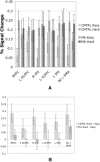Frontoparietal cortical activity of methamphetamine-dependent and comparison subjects performing a delay discounting task
- PMID: 16944492
- PMCID: PMC6871407
- DOI: 10.1002/hbm.20281
Frontoparietal cortical activity of methamphetamine-dependent and comparison subjects performing a delay discounting task
Abstract
Relative to individuals who do not have addictive disorders, drug abusers exhibit greater devaluation of rewards as a function of their delay ("delay discounting"). The present study sought to extend this finding to methamphetamine (MA) abusers and to help understand its neural basis. MA abusers (n = 12) and control subjects who did not use illicit drugs (n = 17) participated in tests of delay discounting with hypothetical money rewards. We then used a derived estimate of each individual's delay discounting to generate a functional magnetic resonance imaging probe task consisting of three conditions: "hard choices," requiring selections between "smaller, sooner" and "larger, later" alternatives that were similarly valued given the individual's delay discounting; "easy choices," in which alternatives differed dramatically in value; and a "no choice" control condition. MA abusers exhibited more delay discounting than control subjects (P < 0.05). Across groups, the "hard choice > no choice" contrast revealed significant effects in the ventrolateral prefrontal cortex, dorsolateral prefrontal cortex (DLPFC), dorsal anterior cingulate cortex, and areas surrounding the intraparietal sulcus (IPS). With group comparisons limited to these clusters, the "hard choice > easy choice" contrast indicated significant group differences in task-related activity within the left DLPFC and right IPS; qualitatively similar nonsignificant effects were present in the other clusters tested. Whereas control subjects showed less recruitment associated with easy than with hard choices, MA abusers generally did not. Correlational analysis did not indicate a relationship between this anomaly in frontoparietal recruitment and greater degree of delay discounting exhibited by MA abusers. Therefore, while apparent inefficiency of cortical processing related to decision-making in MA abusers may contribute to the neural basis of enhanced delay discounting by this population, other factors remain to be identified.
Figures



References
-
- Ainslie G (1975): Specious reward: a behavioral theory of impulsiveness and impulse control. Psychol Bull 82: 463–496. - PubMed
-
- Ainslie G (2004): Gods are more flexible than resolutions. Behav Brain Sci 27: 18–19.
-
- Ainslie G, Haendel V (1983): The motives of the will In: Gottheil E, Druley K, Skodola T, Waxman H, editors. Etiology Aspects of Alcohol and Drug Abuse. Springfield, IL: Charles C. Thomas: 119–140.
-
- Baddely A (1986): Working memory. London: Oxford University Press.
-
- Bechara A, Damasio AR, Damasio H, Anderson SW (1994): Insensitivity to future consequences following damage to human prefrontal cortex. Cognition 50: 7–15. - PubMed
Publication types
MeSH terms
Substances
Grants and funding
LinkOut - more resources
Full Text Sources
Other Literature Sources
Medical
Molecular Biology Databases

